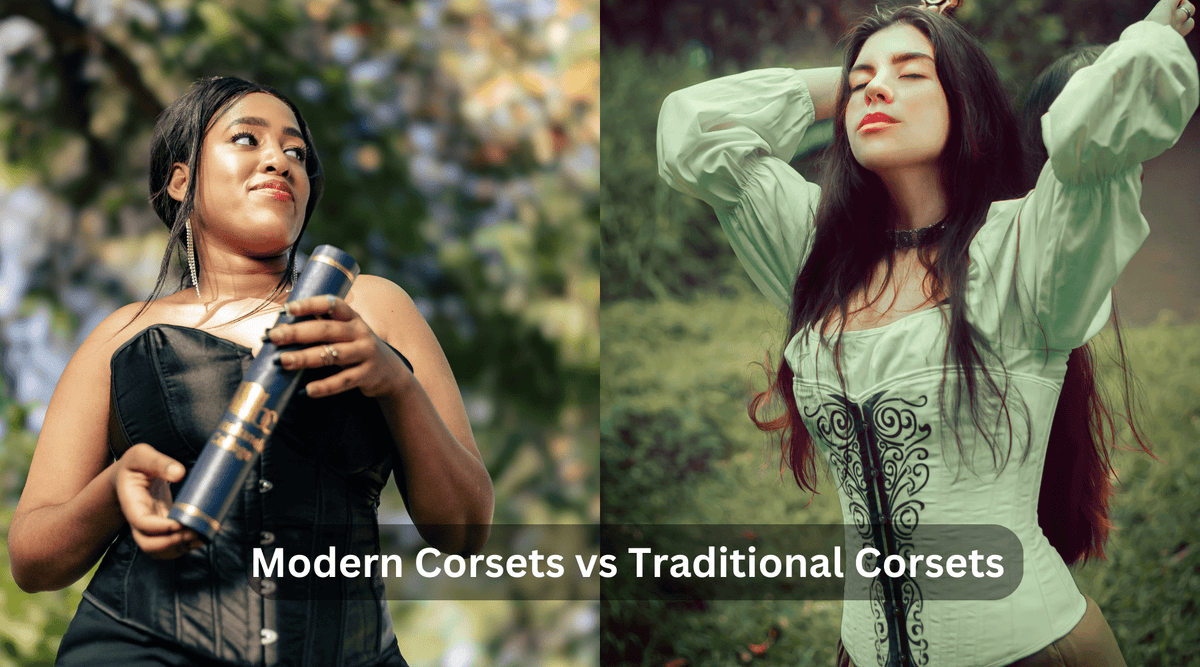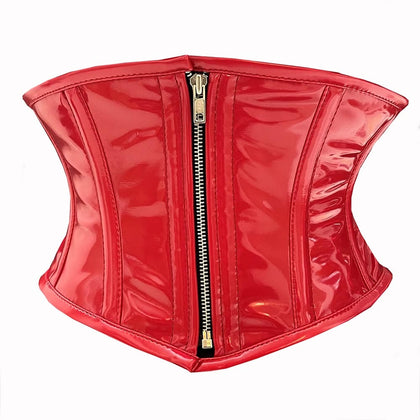

Corsets have long been a subject of debate – some consider them uncomfortable and harmful, while others find them to be stylish and empowering. In this article, we'll dive into the world of corsetry, uncovering the truth behind common assumptions, exploring the differences between modern and historical corsetry, and what the main difference is between Modern Corsets vs. Traditional Corsets.
Table of Content
What are Traditional Corsets?
Traditional corsets are garments that have been worn for centuries to shape and alter the body's appearance, especially the waist. They were popular in different historical periods and were designed to create a particular silhouette, often emphasizing an hourglass figure. These corsets were usually made with strong materials like boning and laces, which were used to tighten and cinch the waist tightly.
They were commonly worn as undergarments and were used to reshape the waistline by pulling it in and creating a narrower waist while accentuating the bust and hips.
The process of wearing a traditional corset could be quite intense. Tight lacing, the practice of cinching the corset as tightly as possible, was often employed to achieve the desired waist size. However, this could lead to discomfort, difficulty in breathing, and even health issues if taken to extreme levels.
Traditional corsets were a significant fashion and societal element in various cultures, reflecting the beauty standards and ideals of their times. While they provided a certain aesthetic and silhouette, they also caused controversies due to their restrictive nature and potential health risks associated with prolonged use.
Want to know more about the history of corsetry read our Article
In modern times, traditional corsets have largely evolved into more comfortable and flexible garments, known as modern corsets, which maintain the shaping concept but prioritize comfort and personal expression.

Checkout our Comfortable Modern Corsets
Further Readings
→ The Ultimate Guide to Achieving the Perfect Corset Fit
What are Modern Corsets?
Modern corsets are typically designed with a combination of traditional corsetry elements and modern materials, allowing for greater flexibility and movement while still providing some degree of shaping.
They come in various styles, such as overbust (covering the breasts) and underbust (ending below the bust), and can be made from a range of fabrics, including satin, lace, leather, and more.
These corsets are often worn as fashion statements or as part of alternative and creative styles.
They might not be as constricting as historical corsets, but they still offer some level of waist-cinching and shaping effect.
Modern corsets can be worn as outerwear, incorporated into costumes, or as accessories to enhance an outfit.
It's worth noting that some modern corsets are designed with more emphasis on comfort and less on extreme waist reduction. They can be adjustable and flexible, making them more suitable for everyday wear without causing discomfort or restricting movement.
Additionally, modern corsets can also be associated with the lingerie industry, where they are designed to emphasize curves and enhance the body's natural shape, offering support and style simultaneously.
Overall, modern corsets are a fusion of historical fashion elements and contemporary design, catering to a variety of preferences and styles while putting an emphasis on comfort and individual expression.

Difference between Modern Corsets vs Traditional Corsets
Hey there, let's delve into the intriguing world of corsets and explore some fascinating differences that have evolved over time.
Strong boning Structure
Corsets have a long history of being worn to shape the body. They were used to make the waist look smaller and to enhance the curves of the hips and bust, creating what's called an "hourglass" figure.
The key change in modern corsets is the use of steel boning, which provides a strong and supportive structure. In the past, corsets were stiffened using a material called baleen, which is found in the mouths of certain whales. This baleen was strong but had its limitations—it could break over time, especially when tightly laced.
Nowadays, corsets are made with steel boning that won't break and are safe to wear without any risk of harm. So, the old idea that corsets could "break a bone" actually came from the use of baleen in the past.
However, you can wear modern corsets with confidence, knowing they are designed to be safe and comfortable. It's always a good idea to know how to wear corset safely and effectively.
Corsets vs Bras
In the past, corsets were not just about shaping the body; they were considered essential undergarments, much like how bras are today. It was common for women to wear corsets as a normal part of their clothing, and going without a corset was seen as improper or indecent.
Interestingly, the term "loose" to describe someone who is promiscuous comes from the practice of leaving corsets loosely laced by certain women, like those working at night.
They did this for their clients' convenience. However, times have changed, and now you have the choice of whether to wear a corset or not. Corsets have evolved from being a necessity to being a fashion choice and a form of self-expression.
Providing back support
Another notable difference between Transitional vs modern corsets is their role in providing back support. While older corsets might have unintentionally offered some relief from back pain, modern corsets are sometimes used intentionally to provide back support, acting like a more aesthetically pleasing alternative to back braces.
So, while in the past, corsets were primarily about shaping the body, today they can serve a practical purpose in supporting spinal health and comfort. This shift highlights the adaptability of corsets and how they've transformed from purely fashion items to functional tools for well-being.
Modern vs. Historical Corsetry Design:
A modern corset may seem more straightforward and less curvaceous, with flat bones compressing the body. On the other hand, historical corsets flaunt a more shapely form, complete with curves to accommodate natural body contours.
These differences stem from the construction techniques and materials used in each era, as well as the purposes they served.
Mass-Manufactured vs. Well-Constructed Modern Corsetry:
Don't be quick to judge all modern corsets as one-size-fits-all. There's a wide spectrum when it comes to quality and construction. Mass-manufactured corsets might not prioritize comfort, using cheaper materials and lacking proper research into corsetry's history.
However, well-constructed modern corsets do exist, designed by enthusiasts who've studied the techniques that made historical corsets comfortable and supportive. These modern artisans prioritize both fashion and function.
Comfort and Discomfort: A Balancing Act:
The notion of comfort in corsetry isn't one-size-fits-all. Some wearers embrace a bit of discomfort for the sake of fashion or specific occasions. Just as we accept the pain of high heels for an elegant look, some choose corsets that aren't meant to be cozy.
However, the corset community has evolved to offer options that prioritize comfort without compromising style. It's all about personal preferences and understanding that discomfort doesn't always equate to negative experiences.
Diverse Body Types and Fitting:
Corsetry's suitability varies based on body types and personal squishiness levels. One-size-fits-all doesn't apply here. Just as shoes come in numerous styles, corsets should adapt to different body shapes.
The Victorian era acknowledged this diversity, offering corsets with various stiffening materials and shapes to suit different bodies and preferences. Embracing one's body type and understanding that a corset can enhance various features is key.
Breaking the Corset Myths
The comparison between corsets and uncomfortable shoes isn't entirely accurate. Just as shoe styles differ, so do corsets. Modern corsetry serves multiple purposes, from fashion statements to functional undergarments. Society's perspective on what's fashionable and comfortable evolves, and it's important to question preconceived notions.
Conclusion: Modern Corsets vs Traditional Corsets
In the world of corsets, there's more than meets the eye. Modern and historical corsets each have their own merits, and comfort is subjective. Mass-manufactured corsetry might not suit everyone, but well-constructed options do exist. Embrace your body type, question assumptions, and explore the vast array of choices corsetry offers. Remember, it's not just about fashion – it's about finding the right balance between comfort and style.



